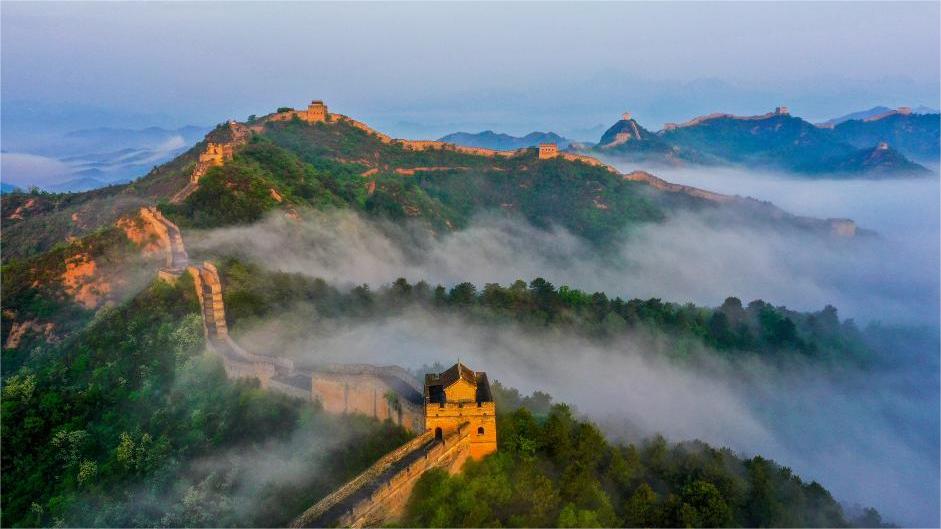Exploring China's high-quality development through Xi's local inspection tours
BEIJING, Dec. 29 (Xinhua) -- In 2023, China prioritized high-quality development as it positioned itself for economic recovery after three years of COVID-19 containment, resulting in solid progress.
Making high-quality development a primary task in achieving the broader goal of building a modern socialist country in all respects, China is endeavoring to effectively upgrade and appropriately expand its economic output.
With this task in mind, President Xi Jinping, also general secretary of the Communist Party of China Central Committee and chairman of the Central Military Commission, has traveled across the country throughout the year, spanning from the dynamic Yangtze River Delta in the east to the vast landscapes of Xinjiang in the west, and from the vibrant Guangdong in the south to the northern reaches of Heilongjiang.
Following Xi's inspection journey, here is a glimpse of the key elements essential for achieving high-quality development -- an ongoing focal point for China in 2024.
INNOVATION-DRIVEN DEVELOPMENT
During his inspection tours, Xi has consistently underscored the vital role of scientific and technological innovation.
Visits to sites like a new energy vehicle assembly workshop, a chip production workshop, a 6G lab, and a helicopter assembly workshop allowed him to gain firsthand insights into breakthroughs in core technologies. Innovation, he stressed, is at the heart of China's modernization drive.
China is actively implementing its innovation-driven development strategy. It has set grand development objectives for 2035, aiming to join the ranks of the world's most innovative countries, with great self-reliance and strength in science and technology.
Xi has long stressed the significance of the Yangtze River Delta. This region, comprising Shanghai, Jiangsu, Zhejiang and Anhui, stands out as one of the most vibrant hubs for innovation, openness and economic activity in China.
In the first three quarters of 2023, the output value of the high-tech manufacturing sector in the region accounted for 31.1 percent of the national total, leading the country in integrated circuits, biopharmaceuticals, artificial intelligence, and the new energy vehicle industry.
While inspecting the Purple Mountain Laboratories in Jiangsu in July, Xi said that disruptive technologies could emerge at any time amid the rapid advancement of information technology. He called for pursuing a pragmatic and solid path of innovation to build self-reliance and strength in science and technology.
He encouraged young R&D professionals to pursue a lifelong commitment to delving into cutting-edge technologies and forging a life of value.
During his trip to Shanghai from Nov. 28 to Dec. 2, Xi urged the metropolis to strive to build an international center for economy, finance, trade, shipping and sci-tech innovation.
On numerous occasions, Xi has highlighted the spearheading role of sci-tech innovation in modernizing the industrial system, aiming to boost the resilience and security of both industrial and supply chains.
Addressing a key meeting in Heilongjiang in September, Xi said the key to revitalizing northeast China lies in sci-tech innovation. It is essential to foster strategic emerging industries including new energy, new materials, advanced manufacturing and electronic information, and nurture industries of the future in order to boost new growth drivers, he said.
GREEN DEVELOPMENT
China's efforts to achieve high-quality development hinges crucially on steering its economic and social progress toward greener and lower-carbon practices. According to Xi, embracing green development is an inevitable path.
Green transformation, carbon reduction, pollution control and ecological protection have been prominent themes during Xi's inspection trips.
In major coal production areas like Shaanxi and Inner Mongolia, Xi stressed the importance of restructuring the energy sector and upgrading the energy industry. He urged a proactive and cautious approach to achieving carbon peak and carbon neutrality goals.
When visiting a refining and chemical enterprise along the Yangtze River in Jiangxi in October, Xi urged efforts to establish globally leading refining and chemical enterprises that are both eco-friendly and intelligent.
He has also underscored China's commitment to prioritizing ecological conservation and fostering harmony between humanity and nature in pursuit of Chinese modernization through high-quality development.
In June, Xi was on an inspection trip to Inner Mongolia, a region grappling with severe desertification. During the trip, he highlighted the importance of implementing comprehensive measures to address the pressing global ecological issue of desertification, noting that it is crucial for the sustainable development of the Chinese nation.
PROSPERITY FOR ALL
Guided by a people-centered development philosophy, Chinese modernization seeks to bring prosperity to the country's entire population of 1.4 billion while preventing social polarization -- an approach that sets Chinese modernization apart from the Western model.
China faces wide gaps in development and income distribution between urban and rural areas and between regions, and these challenges are precisely the focus of Xi's inspections.
Throughout this year, he has made a point of visiting diverse rural landscapes, ranging from a lychee orchard to a plot of saline-alkali wheat field, as well as a border village at the northernmost tip and a village at the heart of a wetland park.
Xi has stressed the urgency of advancing the modernization of agriculture and rural areas, and emphasized promoting rural revitalization by fostering industries and tourism with distinctive local features and advantages.
In Lizu, a village in Zhejiang that has vanquished poverty to become a tourist hotspot, Xi described the progress made in promoting common prosperity as a microcosm of Zhejiang's remarkable achievements in bolstering rural development.
In China's pursuit of common prosperity, border areas with mainly ethnic minority populations must not be left behind, according to Xi. During a trip to Guangxi in December, he called on the region, which has the largest population of ethnic minorities, to narrow the gaps between urban and rural areas, and among various regions and ethnic groups.
Coordinated regional development is crucial for achieving high-quality development. Amid his busy inspection trips, Xi examined China's progress in fostering collaboration within and between regions, including the development of the Guangdong-Hong Kong-Macao Greater Bay Area, the Beijing-Tianjin-Hebei region, and the Yangtze River Economic Belt.
Embracing a deep connection with the people, Xi made a point to visit those who went through tough times during his trips. Following massive floods that hit the north and northeast regions this summer, Xi undertook separate tours of Heilongjiang, Beijing and Hebei. There, he visited the homes of the affected residents, offering support and assessing local post-disaster recovery and reconstruction efforts.
HIGH-STANDARD OPENING UP
This April, Xi chose Guangdong for his first local inspection of the year. Known as a trailblazer and experimental hub in China's reform and opening up, Guangdong has witnessed an astonishing economic surge, doubling to around 13 trillion yuan (about 1.83 trillion U.S. dollars) over the past decade.
The southern province has taken the lead in foreign trade, and boasted an impressive actual utilization of foreign capital exceeding 1.4 trillion yuan over the past 10 years.
While visiting the Guangzhou manufacturing base of LG Display, Xi said that the Chinese market is vast like an ocean, and it stands as the world's largest consumer hub. LG Display, headquartered in the Republic of Korea, has selected Guangzhou as the site for its primary global production base.
"China remains steadfast in its commitment to the long-term and consistent policy of reform and opening up. We won't shut our doors; in fact, we're dedicated to widening our gates of openness even further," Xi said.
In Shanghai, another pivotal player in China's reform and opening up, Xi called for efforts to steadily expand institutional opening up concerning rules, regulations, management and standards. He emphasized the need to advance high-level openness in cross-border services trade and investment, and elevate the openness of the manufacturing industry.
While inspecting inland provinces such as Shaanxi and Jiangxi, he highlighted the importance of propelling development through openness. He urged the provinces to establish a focal point for reform and opening up in inland regions, and contribute to and integrate into China's new development pattern.
During his trips to border areas, Xi also stressed the importance of high-standard opening up. In his inspection tour of Guangxi following his state visit to Vietnam in December, Xi urged the region to expand both internal and external opening up. Guangxi should actively support the development of a China-ASEAN community with a shared future by deepening cooperation with ASEAN countries in trade, labor, industry, science and technology, and education, he said.
Photos
Related Stories
- Xi's ties with Iowa remain strong
- Conference maps path for foreign affairs
- Central conference on work relating to foreign affairs held in Beijing
- Xi's speech at meeting with representatives of young Chinese, Vietnamese, people who have contributed to China-Vietnam friendship published
- Symposium held to commemorate 130th anniversary of Comrade Mao Zedong's birth, Xi delivers important speech
Copyright © 2023 People's Daily Online. All Rights Reserved.









